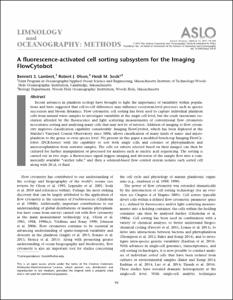| dc.contributor.author | Lambert, Bennett S. | |
| dc.contributor.author | Olson, Robert J. | |
| dc.contributor.author | Sosik, Heidi M. | |
| dc.date.accessioned | 2021-07-08T20:51:41Z | |
| dc.date.available | 2021-07-08T20:51:41Z | |
| dc.date.issued | 2017 | |
| dc.identifier.citation | Lambert, B.S., Olson, R.J. and Sosik, H.M. (2017) A fluorescence-activated cell sorting subsystem for the Imaging FlowCytobot. Limnology and Oceanography: Methods, 15: pp.94-102. DOI: https://doi.org/10.1002/lom3.10145 | en_US |
| dc.identifier.uri | https://repository.oceanbestpractices.org/handle/11329/1613 | |
| dc.identifier.uri | http://dx.doi.org/10.25607/OBP-1544 | |
| dc.description.abstract | Recent advances in plankton ecology have brought to light the importance of variability within populations and have suggested that cell-to-cell differences may influence ecosystem-level processes such as species succession and bloom dynamics. Flow cytometric cell sorting has been used to capture individual plankton cells from natural water samples to investigate variability at the single cell level, but the crude taxonomic resolution afforded by the fluorescence and light scattering measurements of conventional flow cytometers necessitates sorting and analyzing many cells that may not be of interest. Addition of imaging to flow cytometry improves classification capability considerably: Imaging FlowCytobot, which has been deployed at the Martha's Vineyard Coastal Observatory since 2006, allows classification of many kinds of nano- and microplankton to the genus or even species level. We present in this paper a modified bench-top Imaging FlowCytobot (IFCB-Sorter) with the capability to sort both single cells and colonies of phytoplankton and microzooplankton from seawater samples. The cells (or subsets selected based on their images) can then be cultured for further manipulation or processed for analyses such as nucleic acid sequencing. The sorting is carried out in two steps: a fluorescence signal triggers imaging and diversion of the sample flow into a commercially available “catcher tube,” and then a solenoid-based flow control system isolates each sorted cell along with 20 μL of fluid. | en_US |
| dc.language.iso | en | en_US |
| dc.rights | Attribution-NonCommercial 4.0 | * |
| dc.rights.uri | http://creativecommons.org/licenses/by-nc/4.0/ | * |
| dc.subject.other | Fluorescence measurement | en_US |
| dc.subject.other | Flow cytometry | en_US |
| dc.subject.other | Cell sorting | en_US |
| dc.title | A fluorescence-activated cell sorting subsystem for the Imaging FlowCytobot. | en_US |
| dc.type | Journal Contribution | en_US |
| dc.format.pagerange | pp.94-102 | en_US |
| dc.identifier.doi | https://doi.org/10.1002/lom3.10145 | |
| dc.subject.parameterDiscipline | Zooplankton | en_US |
| dc.bibliographicCitation.title | Limnology and Oceanography: Methods | en_US |
| dc.bibliographicCitation.volume | 15 | en_US |
| dc.description.sdg | 14.a | en_US |
| dc.description.eov | Zooplankton biomass and diversity | en_US |
| dc.description.adoption | Validated (tested by third parties) | en_US |
| dc.description.sensors | Imaging FlowCytobot | en_US |
| dc.description.methodologyType | Method | en_US |
| obps.contact.contactname | Heidi M. Sosik | |
| obps.contact.contactemail | hsosik@whoi.edu | |
| obps.resourceurl.publisher | https://aslopubs.onlinelibrary.wiley.com/doi/full/10.1002/lom3.10145 | |
 Repository of community practices in Ocean Research, Applications and Data/Information Management
Repository of community practices in Ocean Research, Applications and Data/Information Management

